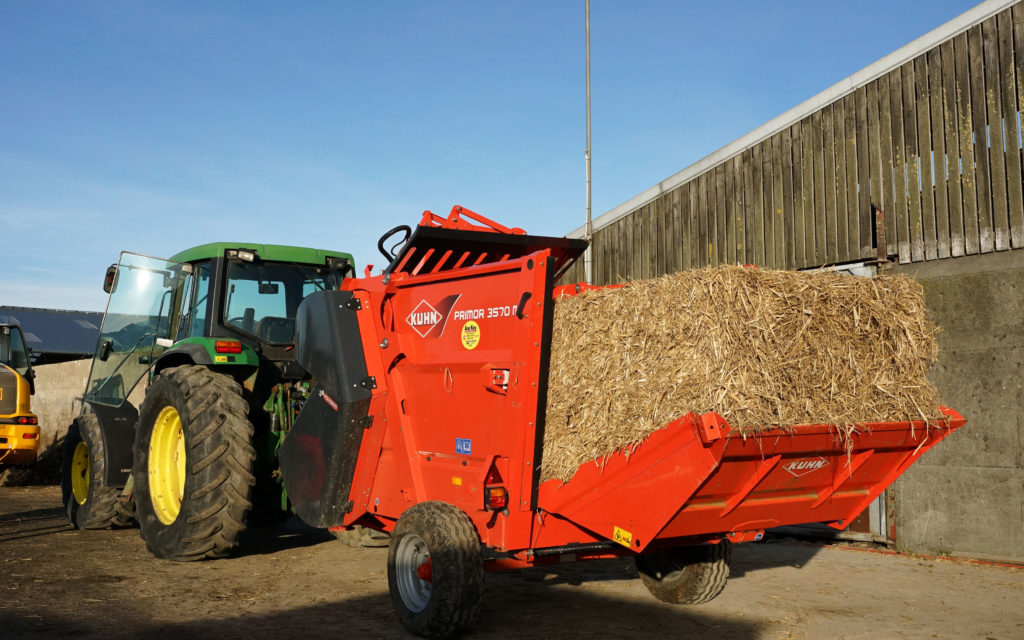With the onset of the spring calving season dairy farms are busy places with not only the rush of young stock, but also the feeding of both dry cattle and those in the early stages of lactation.
Complete diet feeding is one answer to easing the management of herds that may have differing dietary requirements.
It is also widely considered to help ruminants make better use of feed ingredients if they are mixed rather than fed separately, leading to increased total solids in the milk.
Feeding at Gurteen Agricultural College
A popular type of machine by which to blend the fodder and concentrates is the tub or vertical mixer wagon which, at first sight, would appear to offer little scope for variation between makes, however, the devil, as always, is in the detail.

Recently, Kuhn held a demonstration day at Gurteen Agricultural College in conjunction with the local dealer, Alan King Agri Sales of Roscrea.
Kuhn had brought along a 20m3 twin tub mixer wagon from its Profile range and a Primor trailed straw blower to put through their paces.
Agriland got to see an example of the Kuhn feeder in action - check out our video below.
Mixing vertically
The basic tenet of complete diet feeding is that the ration is prepared so that each animal receives exactly the same level of nutrition.

Naturally, this starts with getting the correct ratio of ingredients into the tub and Kuhn's system is based on having a load cell on each axle as well as one on the drawbar.
With these three sensors the company claims that the ration can be weighed to the nearest kilogramme, the total being displayed on the machine itself and a bluetooth connected screen in the loader cab, which has a range of around 90m.

There are various levels of digital sophistication which allows remote downloading of rations and record keeping, depending on the intensity of stock management in place.
The ingredients are best added in ascending order of inclusion, starting with the least and working up the the main forage item which, in this case, is pit silage.
The mix being prepared on the day was for dry cows as they had only the one early calf at the time Agriland visited.

This included a certain amount of straw which had already been teased out of the bale by the straw blower.
Kuhn is quick to point out that although the Primor 3570 does have a reducing effect on straw length, it is sold as a blower rather than a chopper.

That said, the use of straw that has been teased from a bale and passed through the fan blades does save a great deal time and fuel when compared to the use of unprocessed straw.
The college had the mixer attached to a John Deere 6155M which provides 155hp. This is ample for this size of mixer, Kuhn suggests that 7hp per m3 is a good guide to power requirement.

The options available for feeding out the mix are numerous. The doors can be located at various points on the tub while the belt be driven either way and have an elevator attached for feeding into troughs.

A casual examination of the feed being put in front of the animals showed a consistent mix with the beet portion evenly distributed throughout the silage and the straw finely ground down.
Blowing straw
Straw blowers might appear one of those items which bring convenience but are hardly essential and therefore appear well down the bucket list of many farmers.

Yet, that would be ignoring not only the time and effort which they save, but also the more efficient use of straw as it is laid down in the bedding areas as a consistent blanket rather than randomly scattered lumps.
Not only does this consistency reduce wastage of the bedding, but when it comes to spreading, there are no chunks of dung that lie around on the field all winter waiting for the warmer weather to return before eventually rotting away.
Why buy a blower?
The decision to buy will be influenced on whether straw is regarded as a valuable input or just a handy waste product that doesn't necessarily require a machine to process it.

On the demonstration day, one bale was evenly and generously placed over an areas of four pens that normally took one and half when rolled out by hand.
Whether less straw being used would mean that the job would need to be done more often couldn't be determined immediately, yet it seemed unlikely as the machine left a deep clean litter that was evenly spread.
Two bale capacity
The blower being shown was a Primor 3570M trailed machine that is suitable for smaller tractors which might not have the weight to counterbalance a mounted unit, especially if being used to feed silage.

A minimum of 60hp is recommended when on straw, however, if it is to be used for feeding silage, then another 10hp at least is recommended.
Being the sort of machine that is likely to be used in lots of short, regular sessions, finding a used tractor to keep attached to it needn't be a great expense. Otherwise, time saved over spreading by hand could easily be lost in hitching it to the tractor every day.
Self loading
This particular machine is a two bale model that can be self loaded if the bale is positioned on the ground. The rear door can be operated from inside the cab or there are duplicate controls mounted on the side at the rear.

It has an eight blade blower which can be set to run at two speeds with the drive to the feed roller being by a five V polybelt that is hydraulically engaged. A wide angle PTO comes as standard.

